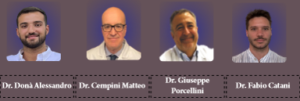Focused Shockwaves in Musculoskeletal Pathology: A trip to Cosenza
Editorial | Vol 3 | Issue 1 | Jan – June 2023 | page: 07-08 | Donà Alessandro, Cempini Matteo, Giuseppe Porcellini, Fabio Catani
DOI: 10.13107/jrs.2023.v03.i01.69
Author: Donà Alessandro [1], Cempini Matteo [2], Giuseppe Porcellini [3], Fabio Catani [4]
[1] Università degli Studi di Modena e Reggio Emilia,
[2] Università di Modena e Reggio Emilia,
[3] Direttore Unità di Ortopedia e traumatologia università di Modena e Reggio Emilia,
[4] Direttore scuola di Specializzazione di Ortopedia e Traumatologia Università di Modena e Reggio Emilia.
Address of Correspondence
Dr. Donà Alessandro,
Università di Modena e Reggio Emilia.
E-mail: alessandro.dona@edu.unife.it
Editorial:
On March 25, 2023, the congress on therapy with focused shockwaves in musculoskeletal pathology was held in the beautiful setting of the archbishop’s curia in the city of Cosenza.
The congress was attended by international experts in the treatment of tendinopathies and non-union.
The main topic of discussion was the comparison between conservative treatment of these pathologies and surgical treatment, and the comparison of the efficacy of shockwaves with other conservative methods.
The topics discussed were numerous, starting with the experience with the use of shockwaves by colleagues from Argentina with a lectio magistralis by Dr. Daniel Moya on the indications and application of this technique in their latitudes, opening an interesting discussion on treatment protocols (pathology to be treated, number of sessions, and number of shockwaves delivered), and showing how a uniform consensus regarding the clinical practice of this technique has not yet been reached, although the results in the literature are encouraging.
The biological aspects of shockwave functioning were addressed thanks to the experience of Dr. Maria Cristina D’Agostino, highlighting how shockwaves primarily have an effect on the stimulation of endothelial cells for the modulation of inflammation, thanks to the production of TLR-3, creating an early pro-inflammatory effect, followed by a delayed anti-inflammatory response. Furthermore, the main mechanisms of action of shockwaves, such as the synthesis of growth factors (VEGF, BMPs), angiogenesis and vasculogenesis, lymphangiogenesis, and stimulation of the proliferation, differentiation, and migration of stem cells were addressed. At the basis of these biological mechanisms would be macrophages, and shockwaves are responsible for modulating the cross-road of macrophages from the M1 (pro-inflammatory) phase to the M2 (anti-inflammatory and regenerative) phase. Regarding delayed bone healing, it emerged that shockwaves stimulate a reduction of the RANKL/OPG factor, generating an inhibition of osteoclastogenesis.
The presentation by the working group of Dr. Elizaveta Kon on orthobiology in tissue regeneration in both tendinopathies and delayed healing was also interesting, showing technological novelties such as Lipocell in the treatment of osteoarthritis and synthetic bone substitutes used in cases of non-union.
A large space was reserved for the analysis of the biological aspects and risk factors of rotator cuff tendinopathies, with the report by Prof. Gumina, who showed the histological differences between healthy tendon tissue and pathological tendon tissue, highlighting how microcirculation deficit is at the basis of these histopathological conditions.
Prof. Porcellini instead showed the main biomechanical and etiological aspects involved in calcific and non-calcific rotator cuff tendinopathies, analyzing the classification and diagnostic aspects. Particular attention was paid to therapeutic indications in the treatment of shoulder tendinopathies, evaluating the possible indications for conservative treatment or surgical treatment, showing the results obtained in the treatment with focused shockwaves in over 200 carefully selected patients based on the type of calcific tendinopathy present, and highlighting some prognostic factors, such as the size and morphological characteristics of calcific deposits, which are decisive in obtaining satisfactory results with shockwaves.
The central part of the conference was finally the analysis of the results obtained from the multicenter study coordinated by Dr. Alfonso Di Giorno, involving the universities of Modena and Reggio Emilia, La Sapienza University, Magna Grecia University and Tor Vergata University where various pathological conditions were treated such as elbow epicondylitis and epitrocleitis, Non-Union, rotator cuff tendinopathies, and Trochanteritis. The results of the study showed that shockwave therapy in the treatment of these pathologies is a safe and reliable method that provides good outcomes in terms of pain response and recovery of function if used by expert personnel able to provide the correct indications and therefore the correct use of such treatment method.

| How to Cite this article: Alessandro D, Matteo C, Porcellini G, Catani F. Focused Shockwaves in Musculoskeletal Pathology: A trip to Cosenza. | Journal of Regenerative Science | Jan – June 2023; 3(1):07-08. |
(Abstract Full Text HTML) (Download PDF)

Leave a Reply
Want to join the discussion?Feel free to contribute!